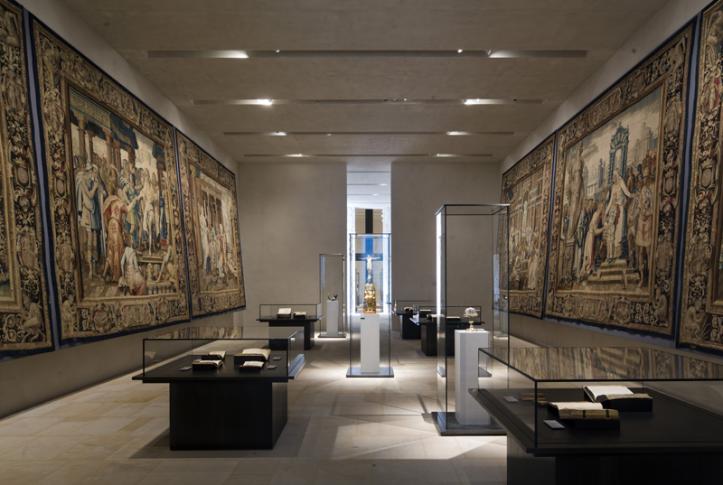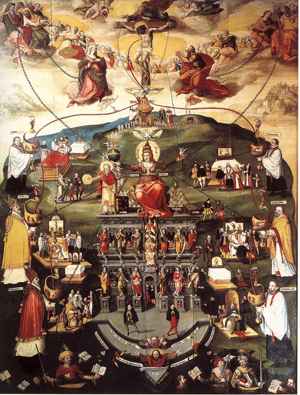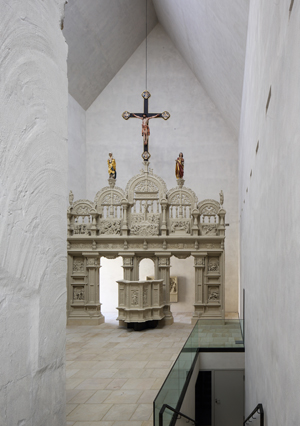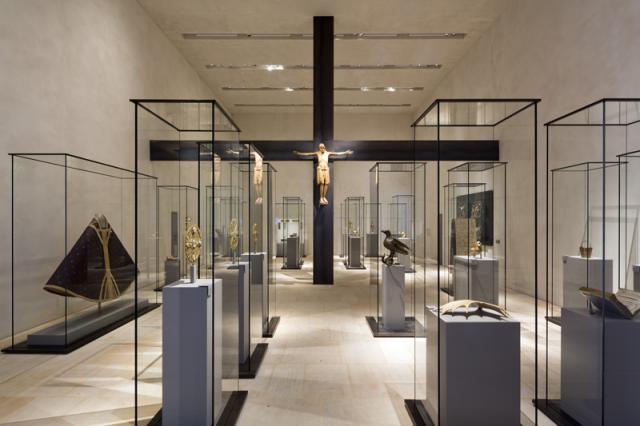Permanent Exhibition: From The Middle Ages To The Modern
Whoever just thinks of medieval treasure when they think of the Hildesheim Cathedral Museum certainly hasn't seen everything. The permanent exhibition unites the Middle Ages with the modern.
In essence, a trip to the Hildesheim Cathedral Museum already begins before stepping foot in the museum, as visitors can access the museum from the Cathedral Foyer on the northern side of the Episcopal Church. The path leads through the Upper Cloister that is currently being used as an exhibition area. Gravestones from the seventh century line the path of the cloister. These monuments, from which the oldest extend back as far to the early days of Hildesheim, remind one of the many generations of ecclesiastical dignitaries who influenced and shaped the region. They document the history of the people from this place during the last 1,200 years.
The main building of the new Cathedral Museum is located on the south wing of the cloister in the rooms of the profaned Anthony's Church which houses the Cathedral Museum's first four exhibition rooms upstairs. The rooms following thereafter display prestigious pieces of artwork dealing with important historical and cultural themes surrounding the Cathedral and the diocese. The Preaching of John the Baptist situated directly across from a small bronze sculpture of Thomas Lehnerer entitled `Methuselah´ points the way to the beginning of the tour through the museum's interior rooms.

The next two rooms contain two baroque collections: the first is made up of six large tapestries from the Cathedral Chapter's old Banquet Hall which are considered some of the best tapestry pieces in existence. They were made at the beginning of the 17th century in the French Court and show the tale of Artemisia, one of the daughters of Zeus, the Greek king of the gods. They were bought for the Hildesheim Cathedral Chapter in the 18th century in order to decorate a Synod Hall located at the Cathedral. It was mistakenly believed that the young ruler shown here depicted Louis the Pious, the founder of Hildesheim. Originally there were eight tapestries, but two of them went missing throughout the turmoil of history. The remaining Gobelin tapestries were extensively restored. It took more than 30 years to finish the work on the valuable items which are now on display to the public for the first time after the end of the Second World War.

In the next exhibition room, the three panels of the Wrisberg Epitaph tell the story of conflicts during the counter-reformation. The triptych was created by the Hildesheim painter Johannes Hopffe in 1585 as an epitaph for canon Ernst von Wrisberg. While the outer panels are inspired by models of the Italian Renaissance and show the Nativity and Resurrection of Christ, the central panel is displayed in the tone of the counter-reformation, illustrating the Roman Church as the sole institution by which redemption can be granted. Across from these paintings hangs a contemporary piece of commissioned artwork by Gerd Finkel, showing the text of one of the oldest Christian poems in the German language – the Wessobrunn Prayer. In the centre of the room, a bible donated by Bishop Bernward can be found, which illuminates the foundations of faith through a compilation of different editions of the bible taken from the rich holdings of the Cathedral Library.
A historical wall, whose oldest components date back to the 11th century, marks a thematic departure to another objective as well as the turning point of the room layout upstairs. Visitors enter into the former Knights' Hall whose design centres around the celebration of the Liturgy. A steel cross spans the room from wall to wall and ceiling to floor, splitting the room into four sections and a life-size crucifix from the Cloister of Ringelheim, a donation made by Bernward around the year 1000, draws particular attention to itself as the central component here. The Ringelheim Crucifix is one of the oldest three-dimensional sculptures of the Middle Ages. The world-famous altar vessels of the Hildesheim Cathedral Treasury surround this cross.
Relics and reliquaries are the next focus of the exhibition, and as a result, the ground-level rooms are dedicated to the themes of finite nature and eternity. A large four-piece work by Gerd Winner called the `End´ dominates the first room. Winner won various national and international prizes for his works and has been closely associated with the Diocese of Hildesheim and the Cathedral Museum for many years.

The monumental piece faces a series of reliquaries, including a beautifully decorated holy skull, which visualises the topic of the existential more closely than the pieces of saint-venerating works which are presented thereafter. Other reliquaries on exhibit – made of various materials including wood, glass or precious metals – stir thoughts on the question of death as the end of life or as a means of passage, whereas precious textile reliquary covers located in the following room sections visualise the Resurrection of Christ on material medium. The artworks, which are associated with the most important holy bishops of Hildesheim Bernward and Godehard, are also of particular importance, as they include famous manuscripts and silver castings from the Bernwardian workshops as well as sensational textile finds from St. Godehard's Shrine.

The tour then leads visitors into the museum's new building, right before the Cathedral's nine-metre-high rood screen, whose sandstone reliefs summarise the key tenets of Christian faith in a comprehensive series of scenes from the Old and New Testaments. Across from this monumental wall of images stands the sculpture known as `Strukturen, vernetzt´ (Structures, interconnected) from Emil Cimiotti, one of the most important representatives of informal art which radically broke itself off from classical sculptural subjects after the Second World War and sought completely new forms of expression.
In the new building's basement, the tour leads through the museum to the roots of the city and the episcopal seat of Hildesheim, where the excavated remains of the Bernward wall – one of Europe's oldest post-antique city walls and which Bishop Bernward had erected around the Cathedral district approx. 1,000 years ago – can be seen here. The wall, which was found during construction in the restoration of the Cathedral, was a surprise to experts: they knew that the wall existed before uncovering it, but never would have suspected finding such extensive and well-preserved remains. These Bernwardian pieces of heritage could now be preserved and accommodated in the new Cathedral Museum's basement. In this section of the museum, archaeological finds reflecting the history of the city and the diocese are displayed.


